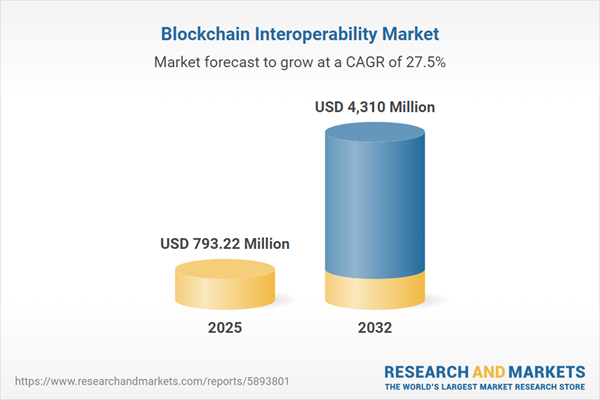Speak directly to the analyst to clarify any post sales queries you may have.
As enterprises accelerate digital infrastructure adoption, the blockchain interoperability market is providing critical solutions for seamless data exchange, network efficiency, and secure business operations. Senior decision-makers are prioritizing enhanced connectivity and future-ready frameworks to drive digital transformation and support regulatory compliance.
Market Snapshot: Blockchain Interoperability Market
The blockchain interoperability market expanded from USD 619.37 million in 2024 to USD 793.22 million in 2025 and is expected to post a CAGR of 27.47%, reaching USD 4.31 billion by 2032. This growth is closely tied to the move from isolated blockchain initiatives toward widespread, interconnected deployments across diverse industries. Enterprises are increasingly leveraging decentralized technologies to improve transparency, automate processes, and address operational priorities. Sectors such as banking, finance, and public services are at the forefront, adopting interoperability to enable efficient, compliant workflows. The market demonstrates rising organizational confidence in technologies that support resilient, integrated digital networks.
Scope & Segmentation
This report delivers detailed segmentation of the blockchain interoperability market, giving executives practical benchmarks for assessing impacts on digital strategy, business models, and geographic deployment.
- Solution Types: Bridges, middleware, orchestration platforms, and protocols connect decentralized systems, supporting secure cross-chain transactions and facilitating efficient data movement between networks.
- Applications: Asset transfers, cross-chain payments, data exchange, and achieving smart contract compatibility drive integration across digital business processes, improving workflow visibility and auditability.
- Deployment Modes: Cloud-based and on-premise options allow organizations to align blockchain adoption with existing IT architectures, security priorities, and risk appetites.
- Organization Sizes: Both large enterprises and small-to-medium businesses are deploying interoperability to foster scalable partnerships, improve compliance, and streamline collaborations within and beyond organizational boundaries.
- End User Industries: Banking, finance, government, healthcare, manufacturing, logistics, and retail/e-commerce are adopting interoperability for improved traceability, regulatory alignment, and secure data exchange.
- Regions Covered: Americas, Europe, Middle East and Africa, and Asia-Pacific reflect a range of technology maturity, regulatory influences, and market adoption drivers, shaping regional strategies and deployment models.
- Key Companies: Chainlink Labs, Web3 Foundation, Ava Labs, Polygon Technology, Interchain Foundation, Quant Network, ICON Foundation, WanChain Foundation, Ren Technologies, and Aion Foundation drive industry standards and innovation.
Key Takeaways
- Enterprise demand for blockchain interoperability is rising as organizations transition from pilot projects to integrated, multi-platform deployments, seeking both compliance and secure transaction frameworks.
- Hybrid blockchain models—encompassing public, private, and consortium deployments—address specific operational, regulatory, and security needs across complex markets, particularly in tightly regulated sectors.
- Governance approaches that blend decentralized technology with formal oversight enable added security by combining on-chain controls with recognized organizational structures.
- Interoperability bridges and middleware facilitate responsive cross-chain transactions and secure identity management, accelerating business continuity and process improvement.
- Regional adoption strategies are influenced by digital readiness, local regulatory environments, and industry priorities, offering opportunities and challenges for global enterprises scaling interoperability solutions.
- Collaboration through sector consortia, standardization efforts, and sharing of best practices streamlines integration efforts and expedites the benefits of interoperable networks.
Tariff Impact on Blockchain Interoperability
Recent tariff changes in the United States are influencing global blockchain interoperability strategies. As hardware costs rise, enterprises are reassessing supplier options, network configurations, and cost structures to maintain reliability and compliance. Solution providers are adapting with deployment models attuned to regional requirements, helping organizations manage evolving trade and regulatory challenges while minimizing operational disruption.
Methodology & Data Sources
Findings from this report are based on a blend of desk research, analysis of public data, and structured interviews with executive leaders and protocol architects across major markets. Blockchain explorer metrics were applied for independent validation of quantitative insights, supplying reliable and actionable intelligence for decision-makers.
Why This Report Matters
- Equips executives with data-driven guidance on technology adoption, regulatory developments, and risk assessment to steer secure, competitive digital strategies.
- Enables informed investment and partnership choices by detailing adoption trends, use cases across regions, and profiles of leading interoperability providers.
- Prepares organizations for digital transformation by highlighting critical use cases and competitive intelligence, supporting proactive leadership in rapidly evolving markets.
Conclusion
Blockchain interoperability is integral to advancing business resilience and digital integration. Leveraging these insights, executives can guide their organizations to harness secure cross-chain ecosystems and adapt business models for sustained growth.
Additional Product Information:
- Purchase of this report includes 1 year online access with quarterly updates.
- This report can be updated on request. Please contact our Customer Experience team using the Ask a Question widget on our website.
Table of Contents
3. Executive Summary
4. Market Overview
7. Cumulative Impact of Artificial Intelligence 2025
Samples

LOADING...
Companies Mentioned
The key companies profiled in this Blockchain Interoperability market report include:- Chainlink Labs, Inc.
- Web3 Foundation
- Ava Labs, Inc.
- Polygon Technology Inc.
- Interchain Foundation
- Quant Network Ltd.
- ICON Foundation
- WanChain Foundation
- Ren Technologies Ltd.
- Aion Foundation
Table Information
| Report Attribute | Details |
|---|---|
| No. of Pages | 182 |
| Published | October 2025 |
| Forecast Period | 2025 - 2032 |
| Estimated Market Value ( USD | $ 793.22 Million |
| Forecasted Market Value ( USD | $ 4310 Million |
| Compound Annual Growth Rate | 27.4% |
| Regions Covered | Global |
| No. of Companies Mentioned | 11 |









